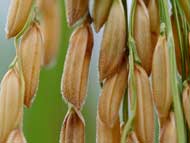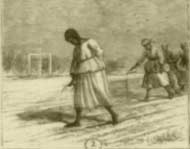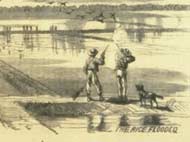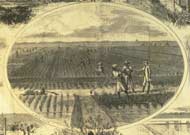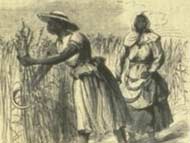Planting Rice
Rice is a semi-aquatic annual grass that was domesticated in Asia and Africa. Rice requires a lot of sun to grow well and takes three to six months to mature and produce seeds. Asian rice is a white rice called Oryza sativa. The African species is a red rice called Oryza glaberrima. Both species were grown in Africa and both species eventually made their way to North America. Generally, red rice was cultivated in the small gardens enslaved people grew for their own families. The white rice was grown by planters for sale because it was sturdier and produced higher yields. This is the rice that became the famous Carolina Gold.
When commercial rice production came to an end at the turn of the 20th century, Carolina Gold seed almost disappeared. In the 1970s, Dr. Richard Schulze, a Lowcountry landowner, tracked down a small sample of seeds in a USDA seed bank in Texas. He began to grow Carolina Gold rice on his Jasper County property as a hobby. Today, there is a small scale operation in Arkansas growing this famous rice.
Whether it was inland rice or tidal rice, the process of planting the seeds and harvesting the grain changed little during the 18th and 19th centuries. Once the rice fields were constructed, slaves created furrows 10 inches apart to mark the rows for planting. They planted seeds along each furrow using the heel-toe method. They walked barefoot along each row and used their big toe to make a hole. They dropped seeds into the hole and then covered and tamped the seeds down with their heel.
When the fields were planted they were flooded with water for 3-6 days until the seeds germinated. This was called the Sprout Flow. The water was then drained and the fields left to dry so the new plants could take root.
Fields were flooded for the second time in May. Again the water was left to stand on the fields for 3-6 days to kill the weeds and insects. At the end of six days the water was drained and the fields left to dry for 40 days. This was called the Stretch Flow.
Slaves spent the rest of the summer hoeing ½-acre sections, a typical daily task. Hoeing was important but back-breaking work. Slaves removed weeds and aerated the soil.
During August and early September slaves gradually added the third flow or Long Water Flow as plants grew and the rice matured. The water supported the plants, now top heavy with grain. Once the rice tassels matured, slaves drained the fields for the last time.
Rice was harvested from late September through November. Slaves used rice hooks to cut the stalks just above ground level. They gathered the dried stalks into sheaves and stacked them on carts. Slaves used flails to thresh the rice stalks to remove the rice.


